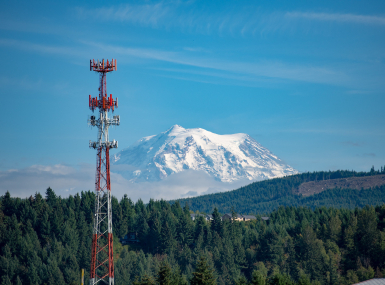FCC takes swing at local control
FCC proposes stripping local governments of siting authority
In the race toward small cell and fifth-generation wireless or “5G,” which allows greater connectivity at higher speeds on communication devices, the Federal Communications Commission (FCC) is considering whether to pre-empt local government regulations when it comes to siting antennas and other infrastructure in public rights of way such as power poles, street lamps and traffic signals.
The FCC on April 20 opened a proceeding to identify and address “unnecessary regulatory barriers to wireless infrastructure deployment.” The Notice of Proposed Rulemaking (NPRM) begins “an examination of how state and local processes affect the speed and cost of infrastructure deployment.” In the FCC’s Notice of Inquiry (NOI), also adopted April 20, the agency asks for comment on two provisions of the Communications Act, Sections 253 and 332, that acknowledge the importance of state and location regulation but “also protect against regulations that impose barriers to entry or are otherwise unreasonable.”
The FCC is seeking input on where the agency should “use its preemption authority to prevent the enforcement of state and local laws that inhibit broadband deployment.”
FCC Chairman Ajit Pai, who moved into the top spot at the federal agency under President Donald Trump, said at a recent open meeting, “I have heard time and time again how current rules and procedures impede the timely, cost-effective deployment of wireless infrastructure. This will only become a bigger problem as our wireless networks evolve. A key feature of the transition from 4G to 5G is a change in network architecture. The future of wireless will evolve from large, macro-cell towers to include thousands of densely-deployed small cells, operating at lower power. As networks evolve, our rules should too.”
The federal agency is considering allowing siting applications to be “deemed granted” if local governments don’t act quickly enough on them. Some of the specifics include shortening the “shot clock” timeframe on applications. A “shot clock” refers to a period of time during which a permitting authority must rule on an application. If the authority does not approve or deny the request before the end of the set time period, the request is deemed granted.
Currently, shot clocks are set at 90 days to act on wireless “collocation” applications and 150 days to act on all other wireless siting applications.
The FCC also wants to stop local governments from enacting temporary “moratoria” on applications. Some jurisdictions do that when they’re swamped with applications. The agency is also looking for examples of excessive fees charged by local governments.
“The Commission cannot continuously hear accounts of deployment hurdles and sit idly by,” said FCC Commissioner Michael O’Rielly. “If this generates the need for preemption, I have no hesitation to use authority provided by Congress to get new wireless services deployed.”
FCC commissioner: Local government ‘on the front lines’
But FCC Commissioner Mignon Clyburn, appointed by President Obama, noted that local governments “are on the front lines addressing the challenges of cost, complexity and time faced by siting applicants, while answering and addressing the never-ending questions, concerns and needs of their communities.”
If the FCC were to mandate preemptive zoning (“deemed granted”), this “will drive up costs to process applications and there is no evidence that carriers face systemic delays,” Montgomery County, Md. officials said in a letter to the FCC.
Montgomery County, Md. Executive Isiah Leggett: Council Vice President Hans Riemer: Tommy Heyboer, deputy chief of staff for Riemer; and H.N. Sonny Segal, chief information officer for the county, visited the FCC in May to discuss their concerns, as did Lamar County, Ga. Commissioner Nancy Thrash, and the Georgia County association’s (ACCG) Legislative Associate Kathleen Bowen, who also met with FCC Wireless Bureau staff and Wireline Bureau staff to discuss concerns with two proposed FCC rules.
“We discussed that we all have the same goals,” Bowen said, “but that the decisions need to be made at a local level — this is a home-rule issue — particularly regarding the public right of way.”
Bowen noted that “counties are already compromising with the wireless industry now. Our elected officials understand the public demand. If the FCC rules are implemented as is, we predict some counties will have to hire additional staff to meet the new timelines. During the meeting, we kept going back to how we believe this is a local issue.”
They also discussed their opposition to preempting or limiting local government ability to negotiate wireline providers in the community for certain services or guarantees as part of access to public rights of way. “Many local governments use these negotiations as a vital tool to ensure that educational institutions or low-income communities receive connectivity and are not ‘redlined’ as technological advances reach some neighborhoods, but not others,” they told the agency.
FCC also looking at historic, environmental impediments
The federal agency is also looking at how complying with the National Historic Preservation Act and National Environmental Policy Act impacts the siting process, examining the current process to see if any changes could be made to “minimize costs and delays.” Representatives from State Historic Preservation Offices in 35 states expressed their concerns to the FCC in a conference call May 22.
Currently state and local regulation is a provision in the Communications Act. The agency sought comment on the measure, which they said acknowledges the importance of state and local regulation but, they said the provision should also protect against regulations that impose barriers to entry or are otherwise unreasonable.
In all, the FCC asked for comments on 130 points in the 66-page NPRM and NOI.
The FCC clarified that all comments are due by June 15 and reply comments by July 17. The NOI was published in the Federal Register May 11; the NPRM was published May 16. To avoid confusion, the FCC noted that comments are due 30 days from May 16 and reply comments 60 days from May 16. To comment, visit: https://www.fcc.gov/ecfs/filings/express; in the top line, labeled “Proceedings,” type “17-84."
There is no specific timeline for when the FCC commissioners might put the measures to a vote. “Given the chairman’s emphasis on infrastructure,” an FCC spokesman said, “he is likely to make this a higher priority.”
Meanwhile state governments are already getting into the act. Virginia, Florida, Colorado and Arizona have all passed legislation further streamlining local regulations. The Florida bill is “a one-way street,” Eric Poole, Florida Association of Counties deputy director of public policy, told a state Senate committee.
“It says the telecommunications industry can come into any county and city, and require us to give them a permit to co-locate one of their small cell packages on any of our utility poles, signs or traffic arm signals,” he said. “We can’t tell them no.”
Virginia State Sen. Chap Petersen (D), a former city council member, said: “We’re telling a for-profit industry we’re going to allow you to supersede all the local zoning regulations. What do we get in return? A comparison has been made to water, power and sewer, but we’re not requiring anything from them [wireless telecommunications companies].”
CTIA, which represents the wireless communications industry, notes that state lawmakers in 19 states have introduced similar legislation.
Attachments
Related News

House committee passes local broadband permitting preemption bills
The American Broadband Deployment Act of 2025 would enact new restrictions on a variety of state and local land use and zoning authorities pertaining to the deployment of telecommunications infrastructure.

White House signs Executive Order on state AI lawmaking
President Trump signed an Executive Order (EO) aimed at mobilizing federal agencies to challenge existing state laws on artificial intelligence.

